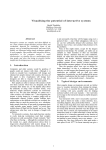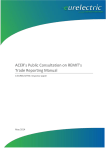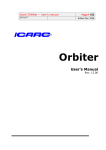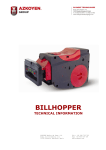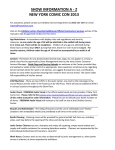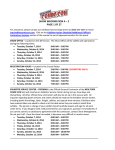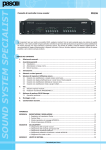Download M - PASO Sound Systems Products
Transcript
DAG9300 Generatore di toni d’allarme e registratore vocale Alarm-tone generator and voice recorder I ISTRUZIONI PER L’USO UK INSTRUCTION MANUAL INDICE DEI CONTENUTI TABLE OF CONTENTS 1. 1. Avvertenze..........................................................................2 1.1 Informazioni generali...................................................2 1.2 Alimentazione e messa a terra....................................2 1.3 Note di sicurezza.........................................................2 Warnings.............................................................................2 1.1 General information.....................................................2 1.2 Power supply and earthing..........................................2 1.3 Safety notes.................................................................2 2. Descrizione generale.........................................................2 2.1 Riferimenti numerati.....................................................2 2. General description...........................................................2 2.1 Numbered references..................................................2 3. Uso......................................................................................3 3.1 Impostazioni all’accensione.........................................3 3.2 Impostazioni e regolazioni...........................................3 3.3 Visualizzazione impostazioni.......................................3 3.4 Abbinamento toni d’allarme/tasti contatti.....................4 3.5 Registrazione messaggio............................................4 3.6 Riproduzione messaggio.............................................4 3.7 Riproduzione tono........................................................4 3.8 Contatto di priorità.......................................................4 3.9 Modalità “DELAY PLAY”..............................................4 3.10 Modalità “REC PLAY”..................................................5 3.10.1 Impostazione della base microfonica...............5 3.10.2 Registrazione di un messaggio........................5 3.10.3 Riproduzione di un messaggio........................5 3. Use.......................................................................................3 3.1 Settings upon switching on..........................................3 3.2 Settings and adjustments............................................3 3.3 Displaying the settings.................................................3 3.4 Association of alarm tones with contact keys..............4 3.5 Recording a message..................................................4 3.6 Playing out a message................................................4 3.7 Playing out a tone........................................................4 3.8 Priority contacts...........................................................4 3.9 “DELAY PLAY” mode...................................................4 3.10 “REC PLAY” mode.......................................................5 3.10.1 Setting the microphone base...........................5 3.10.2 Recording a message......................................5 3.10.3 Playing out a message....................................5 4. Tabelle di riferimento.........................................................6 4.1 Impostazioni di fabbrica...............................................6 4.2 Elenco dei toni disponibili............................................6 4. Reference tables................................................................6 4.1 Factory settings...........................................................6 4.2 List of available tones..................................................6 Caratteristiche tecniche............................................................7 Technical specifications...........................................................7 Nel ringraziarVi per aver scelto un prodotto PASO, vogliamo ricordarVi che la nostra azienda opera con sistema di qualità certificato. Tutti i nostri prodotti vengono pertanto controllati in ogni fase della produzione per garantirVi la piena soddisfazione del Vostro acquisto. Per ogni evenienza la garanzia coprirà, nel periodo di validità, eventuali difetti di fabbricazione. Vi raccomandiamo di leggere attentamente le seguenti istruzioni d’uso per sfruttare appieno le prestazioni offerte da questo prodotto e per evitare eventuali problemi. While thanking you for having chosen a PASO product, we would like to remind you that our company works according to a certified Quality System. This means that all our products are checked during every phase of manufacturing in order to ensure that you will be fully satisfied with your purchase. In any case, the guarantee will cover any manufacturing flaws during the guarantee period. We recommend that you read the following instructions for use and follow them carefully in order to exploit in full the performance of this product and use it correctly. DAG9300 1. AVVERTENZE 1.1 Informazioni generali Tutti gli apparecchi PASO sono costruiti nel rispetto delle più severe normative internazionali di sicurezza ed in ottemperanza ai requisiti della Comunità Europea. Per un corretto ed efficace uso dell’apparecchio è importante prendere conoscenza di tutte le caratteristiche leggendo attentamente le presenti istruzioni ed in particolare le note di sicurezza. Durante il funzionamento dell’apparecchio è necessario assicurare un’adeguata ventilazione. Evitare di racchiudere l’apparecchio in un mobile privo di aerazione o di tenerlo in prossimità di sorgenti di calore. 1. WARNINGS 1.1 General information All PASO equipment is built according to the strictest international safety standards and complies with European Community requisites. In order to use the equipment correctly and effectively, it is important to be aware of all its features by reading these instructions and in particular the notes on safety carefully. While the equipment is working, it is necessary to ensure adequate ventilation. Avoid keeping the equipment near a source of heat (radiator, heating systems and so on). 1.2 Alimentazione e messa a terra Questo apparecchio è predisposto per il funzionamento con tensione di rete a 230 Vca ± 10% 50/60 Hz. L’interruttore di accensione (9) agisce sulla tensione di rete. In dotazione all’apparecchio è fornito un cavo di alimentazione con filo di terra; il terminale di terra della spina di rete non deve essere rimosso in alcun caso. Collegare la spina di rete (10) dell’apparecchio alla rete elettrica utilizzando l’apposito cavo fornito in dotazione; assicurarsi che la presa di corrente sia dotata di collegamento di terra a norma di legge. Il circuito di alimentazione del DAG9300 è protetto da un fusibile situato sulla presa di rete dell’apparecchio. 1.2 Power supply and earthing This equipment is designed to work with a direct voltage of 230 Vca ± 10% 50/60 Hz. In accordance with the safety regulations, the mains switch (9) works only for the mains power supply. The equipment is supplied with a power cable equipped with a ground wire. The corresponding terminal on the mains plug must not be removed under any circumstances. Connect the mains plug (10) to the equipment by using the power cable supplied. Make sure that the power outlet has a ground connection in accordance with the law. A fuse located on the mains plug protects the power supply circuit of the DAG9300. 1.3 Note di sicurezza Ogni intervento all’interno dell’apparecchio, quale operazioni di manutenzione od altro, deve essere effettuato solo da personale specializzato: la rimozione del coperchio rende accessibili parti con rischio di scosse elettriche. Prima di rimuovere il coperchio accertarsi sempre che il cavo di rete sia staccato. Nel caso di accidentale caduta di liquidi sull’apparecchio, staccare immediatamente la spina di rete ed interpellare il centro di assistenza PASO più vicino. La connessione di telaio (11) consente di collegare altre apparecchiature per la sola funzione di schermatura dei segnali a basso livello: questa presa non deve essere utilizzata per il collegamento di sicurezza del telaio alla terra. 1.3 Safety notes Any work inside the equipment, such as selecting some of the modes of operation or applying accessories may only be carried out by specialised personnel. On removing the cover, parts entailing a danger of electric shocks will be made accessible. Always make sure that the mains cable of the power-supply module is disconnected before removing the panels. If any liquid is accidentally spilt on the equipment, disconnect the mains cable immediately and contact the nearest PASO Service Centre. The frame ground connection (11) can be used to connect other equipment for the sole purpose of shielding low-level signals. This socket must never be used for the safety connection of the frame to earth. Avvertenze per lo smaltimento del prodotto ai sensi della Direttiva Europea 2002/96/EC Alla fine della sua vita utile il prodotto non deve essere smaltito insieme ai rifiuti urbani, ma deve essere consegnato presso gli appositi centri di raccolta differenziata predisposti dalle amministrazioni comunali, oppure presso i rivenditori che forniscono questo servizio. Smaltire separatamente un rifiuto elettrico e/o elettronico (RAEE) consente di evitare possibili conseguenze negative per l’ambiente e per la salute derivanti da un suo smaltimento inadeguato e permette di recuperare i materiali di cui è composto al fine di ottenere un importante risparmio di energia e di risorse. Su ciascun prodotto è riportato a questo scopo il marchio del contenitore di spazzatura barrato. Important information for correct disposal of the product in accordance with EC Directive 2002/96/EC This product must not be disposed of as urban waste at the end of its working life. It must be taken to a special waste collection centre licensed by the local authorities or to a dealer providing this service. Separate disposal of electric and/or electronic equipment (WEEE) will avoid possible negative consequences for the environment and for health resulting from inappropriate disposal, and will enable the constituent materials to be recovered, with significant savings in energy and resources. As a reminder of the need to dispose of this equipment separately, the product is marked with a crossed-out wheeled dustbin. Questo prodotto è conforme alle Direttive della Comunità Europea sotto le quali lo stesso ricade. This product is in keeping with the relevant European Community Directives. DAG9300 2. DESCRIZIONE GENERALE Il DAG9300 è un generatore di segnali d’allarme che offre la possibilità di registrare e riprodurre 2 messaggi vocali. Gli allarmi generabili sono 12 (a scelta tra 20 diversi toni sintetizzati disponibili). L’attivazione dei toni e dei messaggi pre-registrati può avvenire tramite tasti frontali oppure tramite contatti posteriori. Inoltre, collegando una postazione microfonica PASO Serie B711 all’ingresso di linea posteriore ed alla morsettiera BASE, è possibile registrare un messaggio vocale e riprodurlo in modo ritardato al termine della registrazione (modalità “DELAY PLAY”) oppure riprodurre il messaggio registrato in precedenza attivandolo dal pulsante a bordo della postazione (modalità “REC PLAY”). 2. GENERAL DESCRIPTION The DAG9300 is an alarm signal generator enabling two voice messages to be recorded and played out. The alarms that can be generated are 12 (to be chosen from among the 20 different synthesised tones at disposal. The tones and pre-recorded messages can be activated either by means of front-panel keys or of rear-panel contacts. Furthermore, if a PASO microphone station of the B711 range is connected to the rear-panel line input and to the BASE terminal block, it is possible to record a voice message and to play it out with a delay at the end of the recording (“DELAY PLAY” mode). As an alternative, a pre-recorded message can be played out by activating it by means of the pushbutton on the station (“REC PLAY” mode). 2.1 Riferimenti numerati 2.1 Numbered references Pannello frontale (1) Altoparlante. (2) Microfono elettrete. (3) Display. (4) Tasto MSG 1 (invio messaggio 1). (5) Tasto MSG 2 (invio messaggio 2). (6) Tasto SET/REC (modifica impostazioni / registrazione messaggi). (7) Tasto VIS/STOP (visualizzazione impostazioni / interruzione riproduzione). (8) Tasti selezione tono (TONE 1÷C). (9) Interruttore d’accensione con spia luminosa. Front panel (1) Loudspeaker. (2) Electret microphone. (3) Display. (4) MSG 1 key (send message 1). (5) MSG 2 key (send message 2). (6) SET/REC key (change settings / recording of messages). (7) VIS/STOP key (display settings / stop playing). (8) Tone-selection keys (TONE 1÷C). (9) ON/OFF switch with LED. Pannello posteriore (10) Spina di rete con fusibile incorporato. (11) Morsetto per connessione telaio. (12) Morsettiera per alimentazione esterna @24Vcc. (13) Morsettiera per collegamento a contatti esterni. (14) Morsettiera relè precedenza. (15) Morsettiera per collegamento a postazioni B711. (16) Regolazione frequenza tono. (17) Prese RCA d’ingresso per sorgenti ausiliarie. (18) Prese RCA per il segnale d’uscita. (19) Regolazione livello ingressi ausiliari. Rear panel (10) Mains plug with built-in fuse. (11) Terminal for connection of frame. (12) Terminal block for external 24 VDC power supply. (13) Terminal block for connection to external contacts. (14) Terminal block for precedence relay. (15) Terminal block for connection to B711 microphone stations. (16) Tone-frequency adjustment. (17) RCA input sockets for auxiliary sources. (18) RCA input sockets for the output signal. (19) Adjustment of level of auxiliary inputs. DAG9300 3. USO 3.1 Configurazione Durante la fase d’accensione dell’apparecchio, è possibile impostare alcuni modi di funzionamento, di seguito descritti in dettaglio. 3. USE 3.1 Configuration When switching on the equipment, it is possible to set several operating modes, described in detail below. • Abilitazione dei tasti Ad apparecchio spento, tenere premuto il tasto MSG 1. Accendere l’apparecchio e rilasciare il tasto: sul display verrà visualizzato il carattere “E” (enabled). • To enabling the keys With the equipment switched off, hold down the MSG 1 key. Switch on the equipment and then release the key: the letter “E” (enabled) will appear on the display. • Disabilitazione dei tasti Ad apparecchio spento, tenere premuto il tasto STOP. Accendere l’apparecchio e rilasciare il tasto: sul display verrà visualizzato il carattere “d” (disabled). • To disable the keys With the equipment switched off, hold down the STOP key. Switch on the equipment and then release the key: the letter “d” (disabled) will appear on the display. • Ripristino impostazioni Ad apparecchio spento, tenere premuto il tasto TONE A. Accendere l’apparecchio e rilasciare il tasto: verranno ripristinate le impostazioni di fabbrica (vedi par. 4.1, pag. 7). • To restore the settings With the equipment switched off, hold down the TONE A key. Switch on the equipment and release the key: the factory settings will be restored (see point 4.1 on page 7). • Formattazione memoria Ad apparecchio spento, tenere premuti contemporaneamente i tasti TONE B e TONE C. Accendere l’apparecchio e rilasciare i tasti: verrà riformattata tutta la memoria interna. Questa operazione può rendersi necessaria in caso la memoria risulti irrimediabilmente corrotta (ad esempio, in seguito ad un black-out dell’energia elettrica durante la registrazione di un messaggio). • To format the memory With the equipment switched off, hold down the TONE B and TONE C keys at the same time. Switch on the equipment and release the keys: the whole internal memory will be re-formatted. This operation may become necessary if the memory is irretrievably corrupt (e.g. following a power outage while a message is being recorded). 3.2 Settings and adjustments While the equipment is working normally, it is possible to set several operating modes, described below: 3.2 Impostazioni e regolazioni Durante il normale funzionamento dell’apparecchio, è possibile impostare alcuni modi di funzionamento, di seguito descritti: • Volume altoparlante – / Volume OUT AUX – Premere il tasto SET/REC e successivamente TONE 1/VOL–. • Loudspeaker volume – / OUT AUX volume – Press the SET/REC key, then the TONE 1/VOL– key. • Volume altoparlante + / Volume OUT AUX + Premere il tasto SET/REC e successivamente TONE 2/VOL+. • Loudspeaker +volume / OUT AUX volume + Press the SET/REC key, then the TONE 2/VOL+ key. • Disabilitazione altoparlante Premere il tasto SET/REC e successivamente TONE 3; il display visualizza il carattere “o”. • Disabling the loudspeaker Press the SET/REC key, then the TONE 3 key; the letter “o” will appear on the display. • Abilitazione altoparlante Premere il tasto SET/REC e successivamente TONE 4; il display visualizza il carattere “F”. • Enabling the loudspeaker Press the SET/REC key, then the TONE 4 key; the letter “F” will appear on the display. • Modalità “REC PLAY” Premere il tasto SET/REC e successivamente TONE 5; il display visualizza il carattere “r”. • “REC PLAY” mode Press the SET/REC key, then the TONE 5 key; the letter “r” will appear on the display. • Modalità “DELAY PLAY” Premere il tasto SET/REC e successivamente TONE 6; il display visualizza il carattere “d”. • “DELAY PLAY” mode Press the SET/REC key, then the TONE 6 key; the letter “d” will appear on the display. • Qualità registrazione > Normale: premere il tasto SET/REC e quindi TONE 7; il display visualizza il carattere “n”. • Quality of recording > Normal: press the SET/REC key, then the TONE 7 key; the letter “n” will appear on the display. > > High: press the SET/REC key, then the TONE 8 key; the letter “H” will appear on the display. • Sorgente di registrazione > MIC: premere il tasto SET/REC e quindi TONE 9; il display visualizza il carattere “N”. • Source of recording > MIC: press the SET/REC key, then the TONE 9 key; the letter “N” will appear on the display. > AUX: premere il tasto SET/REC e quindi TONE A; il display visualizza il carattere “A”. > AUX: press the SET/REC key, then the TONE A key; the letter “A” will appear on the display. • Tone message time > 1 min: premere il tasto SET/REC e quindi TONE B; il display visualizza il carattere “1”. • Tone message time > 1 min: press the SET/REC key, then the TONE B key; the number “1” will appear on the display. > > infinite: press the SET/REC key, then the TONE C key; the number “8” will appear on the display. Alta: premere il tasto SET/REC e quindi TONE 8; il display visualizza il carattere “H”. infinito: premere il tasto SET/REC e quindi TONE C; il display visualizza il carattere “8”. DAG9300 3.3 Visualizzazione impostazioni In fase di funzionamento, è possibile visualizzare (senza modificarli) i parametri sopra descritti eseguendo le medesime operazioni ma sostituendo il tasto VIS/STOP (7) al tasto SET/REC. 3.3 Displaying the settings During operation, it is possible to display the parameters described above (without altering them), carrying out the same procedures but replacing the VIS/STOP (7) key with the SET/REC key. 3.4 Abbinamento toni d’allarme/tasti contatti I tasti TONE 1÷TONE C (8) permettono di riprodurre uno dei dodici toni disponibili. Il tasto TONE 1 corrisponde, come selezione tono, al contatto 1, il tasto TONE 2 al contatto 2 e così via sino al tasto TONE C che corrisponde al contatto 12. Il tasto MSG 1 corrisponde al contatto M1, il tasto MSG 2 corrisponde al contatto M2. E’ possibile abbinare ad ogni tasto TONE uno qualunque dei toni disponibili (vedere la tabella di riferimento a pag. 8). Per effettuare questo abbinamento procedere nel modo seguente: 3.4 Association of alarm tones/contact keys The TONE 1 to TONE C keys (8) each enable one of the twelve available tones to be reproduced. When selecting the tones, the TONE 1 key corresponds to contact 1, the TONE 2 key to contact 2 and so on up to TONE C, which corresponds to contact 12. The MSG 1 key corresponds to contact M1, the MSG 2 key to contact M2. It is possible to associate each TONE key with any one of the available tones (see the reference table on page 8). To set these associations, proceed as follows: 1) Abilitare l’altoparlante e regolarne il volume per permettere un adeguato ascolto dei toni. Se il display mostra un carattere diverso dal trattino (“-”) premere brevemente il tasto VIS/STOP (apparirà il carattere “-”). 1) Enable the loudspeaker and adjust the loudspeaker volume to enable the tones to be heard properly. If a character other than a hyphen (“-”) is shown on the display, press the VIS/STOP key briefly (the character “-” will appear). 2) Premere e mantenere premuto il tasto VIS/STOP (circa quattro secondi) finché il trattino (carattere “-”) inizia a lampeggiare. 2) Press the VIS/STOP key and hold it down (for about four seconds) until the hyphen sign ( “-”) starts to flash. Premendo uno dei tasti TONE: verrà riprodotto il tono attualmente abbinato al tasto stesso; per selezionare un nuovo tono, premere in successione il tasto fino ad ottenere in altoparlante il tono desiderato. Per memorizzare il nuovo abbinamento tasto/tono è sufficiente premere il tasto SET/REC (6). Qualora non si volesse memorizzare il nuovo abbinamento, sarà sufficiente premere nuovamente il tasto VIS/STOP: in questo modo verrà ripristinato l’abbinamento tasti/toni precedente. When one of the TONE keys is pressed: the tone currently associated with it will be played out. To select a new tone, press the key repeatedly until the required tone is reproduced by the loudspeaker. To store this new association between the key and the tone, simply press the SET/ REC key (6). If you do not wish to store the new association, simply press the VIS/ STOP key again: this will cause the previous associations between the keys and the tones to be restored. 3.5 Registrazione messaggio Per effettuare la registrazione di un messaggio procedere così: 1) Premere e mantenere premuto il tasto SET/REC (6), quidi premere il tasto MSG 1 (4) (MSG 2 per il messaggio 2); mantenere questa situazione finchè sul display non apparirà il carattere “E” (erase) che sta ad indicare l’inizio della cancellazione del messaggio scelto. Una volta apparso il carattere “E” rilasciare entrambi i tasti ed attendere che si illumini il punto decimale che sta ad indicare l’inizio della registrazione. 2) Parlare ad una distanza di 10/20 centimetri dal microfono situato sul frontale dell’apparecchio con volume di voce medio alto. Una volta terminata la registrazione premere il tasto VIS/STOP. Qualora la registrazione superi il tempo massimo disponibile, verrà interrotta automaticamente. 3) É possibile scegliere tra due qualità di registrazione, normale o alta (vedi Par. 3.2 Impostazioni / regolazioni durante il funzionamento). Con qualità di registrazione alta si ottiene una registrazione più fedele a scapito però di una riduzione del tempo di registrazione del 33% circa. 3.5 Recording a message To record a message, proceed as follows: 1) Press the SET/REC key (6) and hold it down. Then press the MSG 1 key (4) (MSG 2 for message 2); retain this situation until the letter “E” (Erase) appears on the display to indicate that the chosen message has started to be deleted. Once the letter “E” has appeared, release both keys and wait for the decimal point to light up, showing that the recording has started.. É possibile registrare il messaggio anche dall’ingresso ausiliario: va ripetuta la sequenza precedente dopo avere impostato ‘AUX’ come sorgente di registrazione su (vedi Par. 3.2 Impostazioni e regolazioni). In questo caso, andrà regolato - utilizzando il trimmer (17) - anche il livello di ingresso AUX per ottenere un risultato ottimale. It is also possible to record a message via the auxiliary input: repeat the sequence indicated above after setting ‘AUX’ as the source of the recording (see point 3.2 Settings and adjustments). In this case, it will also be necessary to adjust the AUX input level – using the trimmer (17) – so as to achieve the optimum result. 3.6 Riproduzione messaggio Per riprodurre un messaggio registrato in precedenza è sufficiente, a tasti abilitati, premere il relativo tasto (MSG 1 o MSG 2) oppure chiudere il contatto relativo (contatto M1: MSG 1, contatto M2: MSG 2). 3.6 Playing out a message To play out a message recorded earlier, simply press the associated key (MSG 1 or MSG 2) (with the keys enabled) or close the appropriate contact (contact M1: MSG 1, contact M2: MSG 2). 2) Speak at a distance of 10 to 20 centimetres from the microphone on the front panel of the equipment, at a medium to high volume. Once the recording has been completed, press the VIS/STOP key. If the length of the recording exceeds the available time limit, it will stop automatically. 3) It is possible to choose between two recording qualities: normal and high (see point 3.2 Settings and adjustments). With a high quality, the recording will be closer to the original, but penalising the recording time by about 33%. DAG9300 3.7 Riproduzione tono Per riprodurre un tono è sufficiente, a tasti abilitati, premere il relativo tasto TONE 1÷TONE C oppure chiudere il relativo contatto. Il tasti TONE 1÷TONE C corrispondono ai contatti 1÷C. 3.7 Reproduction of a tone To reproduce a tone, simply press the associated key TONE 1 to TONE C (with the keys enabled) or close the appropriate contact. Keys TONE 1 to TONE C correspond to contacts 1 to C. 3.8 Contatto di priorità Durante la riproduzione di un tono qualunque o di un messaggio viene mantenuto chiuso il contatto pulito “PTY CONT” per eventuale priorità verso apparecchiature esterne. 3.8 Priority contacts While reproducing any tone or playing out any message, the clean contact “PTY CONT” is kept closed, in order to be able to override external equipment. 3.9 Modalità “DELAY PLAY” La modalità “DELAY PLAY” è un’utile funzionalità che permette di effettuare annunci vocali con diffusione ritardata nel tempo, in modo da evitare l’innesco dell’Effetto Larsen* che si crea nei casi in cui il microfono si trovi troppo vicino agli altoparlanti. L’apparecchio è predisposto per un agevole funzionamento con le basi di chiamata Serie B711, ma può essere utilizzato anche con altre apparecchiature, ad esempio alcune interfacce telefoniche, purché queste ultime dispongano di un’uscita audio a livello di linea e di un contatto pulito che si chiuda in concomitanza con l’annuncio. 3.9 “DELAY PLAY” mode The “DELAY PLAY” mode is a useful function for making voice announcements to be broadcast at a later point in time, so as to avoid triggering off acoustic feedback (the so-called Larsen effect*), which is created when the microphone is too close to the loudspeakers. The equipment has provisions for easy operation with the microphone bases of the B711 range, although it can also be used with other equipment, for instance some telephone interfaces, provided these have an audio output at line level and a clean contact that closes at the time of the announcement. Per utilizzare questa modalità con una postazione B711, procedere come segue: 1) collegare la base come illustrato in fig. 3.8.1; 2) impostare la modalità “DELAY PLAY” (vedi Par. 3.2, pag. 3); 3) premere il tasto PTT sulla postazione: partirà la registrazione, parlare con un volume medio alto nel microfono. Al rilascio del tasto PTT avverrà la riproduzione del messaggio registrato in precedenza che, una volta riprodotto, verrà cancellato per permettere una registrazione immediata quando verrà di nuovo premuto. To use this mode with a B711 microphone station, proceed as follows:. * fischio acuto. * screeching sound. Nota: in questa modalità viene utilizzato il messaggio 2; il messaggio 1 rimane quindi a disposizione. Note: In this mode, message 2 is used an message 1 remains on stand-by. “DELAY PLAY” “REC PLAY” Fig. 3.9.1 Fig. 3.10.1 1) Connect the base as illustrated in Fig. 3.8.1; 2) Set the “DELAY PLAY” mode (see point 3.2 on page 3); 3) Press the PTT key on the microphone station to start recording. Speak into the microphone at a medium-to-high volume. When the PTT key is released, the message that was recorded will be played out, after which it will be deleted so as to enable immediate recording of another message when the key is pressed again.. DAG9300 3.10 Modalità “REC PLAY” In questa modalità è possibile, tramite una base di chiamata B711/6G, riprodurre un messaggio registrato precedentemente. 3.10 The “REC PLAY” mode In this mode it is possible to use a B711/6-G microphone base to play out a message recorded earlier. 3.10.1 Impostazione della base microfonica Dopo aver collegato la base come indicato in figura 3.10.1, abilitare la modalità “REC PLAY” (vedi Par. 3.2, pag. 3). Sulla postazione andrà impostato, come tasto d’allarme, un tasto di zona non utilizzato. Per impostare la modalità tasto invio allarme abilitato sulla base, procedere come segue: 3.10.1 Setting the microphone base After connecting the base as indicated in Figure 3.10.1, enable the “REC PLAY” mode (see point 3.2 on page 3). On the station, set a zone key that is not being used as an alarm key. To set the key in the alarm-enabled mode, proceed as follows:. 1) Sulla base, premere contemporaneamente i tasti PTT e LOCK e quindi alimentare la base inserendo il cavo alla presa AUDIO OUT. Il led vicino al tasto PTT emetterà una sequenza di lampeggi.. 1) On the base, press the PTT and LOCK keys both at the same time, then power up the base by plugging the cable into the AUDIO OUT socket. The LED close to the PTT key will produce a sequence of flashes. 2) I led di zona/allarme daranno indicazione della funzionalità correntemente impostata dei tasti a cui si riferiscono: • Spento: tasto di chiamata zona. • Acceso: tasto invio allarme abilitato. • Lampeggiante: tasto invio allarme disabilitato. 2) The zone/alarm LED’s will indicate the functions set currently for the keys to which they refer: • OFF: zone-call key. • ON: key enabled for sounding alarms. • Flashing: key disabled for sounding alarms. Per modificare la funzionalità dei tasti di zona premere il tasto di zona desiderato fino a che il led abbinato al tasto di zona scielto per effettuare la modalità “REC PLAY” rimanga acceso. Per uscire, salvando le impostazioni, premere il tasto PTT; la postazione è immediatamente pronta per l’uso. To change the functions of the zone keys, press the required zone key until the LED associated with the zone chosen for the “REC PLAY” mode remains on. To save the settings and exit, press the PTT key; the station will be ready for immediate use. 3.10.2 Registrazione di un messaggio Per effettuare la registrazione del messaggio in modalità “REC PLAY” procedere come segue: 1) Premere il tasto in precedenza abilitato come tasto di allarme: il led corrispondente inizierà a lampeggiare velocemente. 2) Premere nuovamente il tasto allarme, il led corrispondente inizierà a lampeggiare lentamente. 3) Premere il tasto PTT, il messaggio presente verrà cancellato e dopo circa un secondo inizierà la registrazione del messaggio. Per terminare la registrazione rilasciare il tasto PTT. 4) Premere il tasto di allarme attivato in precedenza, il led relativo si spegnerà. 3.10.2 Recording a message To record messages in the “REC PLAY” mode, proceed as follows:. 1) Press the key previously enabled as an alarm key; the corresponding LED will start to flash fast. 2) Press the alarm key again; the corresponding LED will start to flash slowly. 3) Press the PTT key. The existing message will be erased and after about one second recording of the new message will start. To end the recording, release the PTT key. 4) Press the previously activated alarm key; the associated LED will extinguish. 3.10.3 Riproduzione di un messaggio Per riprodurre il messaggio registrato in precedenza: 1) Premere il tasto di allarme, il led corrispondente inizierà a lampeggiare velocemente. 2) Premere di nuovo il tasto di allarme, inizierà la riproduzione del messaggio pre registrato. 3) Premere nuovamente il tasto: il led si spegnerà. 3.10.3 Playing out a message To play out a previously recorded message, proceed as follows: 1) Press the alarm key; the corresponding LED will start to flash fast. 2) Press the alarm key again; the pre-recorded message will start to play out. 3) Press the key again: the LED will extinguish. Nota: Se nelle modalità “DELAY PLAY” e “REC PLAY” viene utilizzato il messaggio 2, il messaggio 1 rimane a disposizione. Nota: If message 2 is used in the “DELAY PLAY” or “REC PLAY” modes, message 1 remains on stand-by. DAG9300 4. 4. TABELLE DI RIFERIMENTO REFERENCE TABLES 4.1 Factory settings The following table contains a complete list of the parameters set at the factory. The settings can be changed following the procedure indicated under point 3.2 “Settings and adjustments” (page 3). 4.1 Impostazioni di fabbrica Nella tabella sottostante viene riportato l’elenco completo dei parametri impostati in fabbrica, modificabili seguendo le procedure indicate nel. Par. 3.2 “Impostazioni e regolazioni” (pag. 3). parametro Parameter Valore di fabbrica Factory setting Opzioni Options Volume altoparlante / AUX Loudspeaker / AUX volume 6 Min: 1 ÷ Max: 8 Qualità di registrazione Recording quality Alta High Normale / Alta Normal / High Tempo riproduzione toni / messaggi Tone / message playing time Infinito Infinite Infinito / 1 minuto Infinite / 1 minute Sorgente di registrazione Source of recording Microfono elettrete interno. Internal electret microphone Microfono / AUX Microphone / AUX Operatività tasti Operation of keys Abilitati Enabled Abilitato / Disabilitato Enabled / Disabled Operatività altoparlante Operation of loudspeaker Abilitato Enabled Abilitato / Disabilitato Enabled / Disabled Tono Tone TONE 1 Monotonale lento Slow single-tone TONE 2 Monotonale veloce Fast single-tone TONE 3 Bitonale lento Slow-two tone TONE 4 Bitonale veloce Fast two-tone TONE 5 Sirena lenta Slow siren TONE 6 Sirena veloce Fast siren TONE 7 Slow whoop down Slow whoop down TONE 8 Slow whoop up Slow whoop up TONE 9 Whoop olandese (2 volte) Dutch whoop (2 volte) TONE A Whoop olandese continuo Dutch continuous whoop TONE b Allarme francese French alarm TONE C Allarme continuo (tono continuo regolabile) Continuous alarm (adjustable continuous tone) Tasto / Key DAG9300 4.2 Elenco dei toni disponibili Nella tabella sottostante viene riportato l’elenco completo dei toni disponibili. Codice / Code Display 4.2 List of available tones The following table provides a complete list of the available tones. Tono Tone 1 Monotonale lento Slow single-tone 2 Monotonale veloce Fast single-tone 3 Bitonale lento Slow-two tone 4 Bitonale veloce Fast two-tone 5 Sirena lenta Slow siren 6 Sirena veloce Fast siren 7 Slow whoop down Slow whoop down 8 Slow whoop up Slow whoop up 9 Fine allarme inglese English end-of-alarm 10 Whoop inglese English whoop 11 Polizia inglese English police 12 Crash inglese English crash 13 Allarme fuoco inglese English fire alarm 14 Air raid inglese English air raid 15 Allarme fuoco tedesco German fire alarm 16 Fine allarme fuoco tedesco German end-of-fire-alarm 17 Whoop olandese (2 volte) Dutch whoop (2 volte) 18 Whoop olandese continuo Dutch continuous whoop 19 Allarme francese French alarm 20 Allarme continuo (tono continuo regolabile) Continuous alarm (adjustable continuous tone) DAG9300 caratteristiche tecniche Alimentazione da rete dag9300 230 V ±10% 50/60 Hz 5W Alimentazione esterna in corrente continua 24 V 140 mA Numero allarmi / messaggi registrati Tempo massimo di registrazione messaggio technical specifications External DC power supply 12 / 2 Number of alarms / messages recorded norm high 60 sec. Durata riproduzione allarmi 40 sec. 60 sec. / continuo Range frequenza allarme continuo 400 ÷ 900 Hz Continuous alarm frequency range Auxiliary input Sensibilità / Impedenza Sensitivity / Impedance 200 mV / 25 kW Rapporto segnale/disturbo 75 dB Risposta in frequenza S/N Ratio 40 ÷ 20.000 Hz Frequency response Messaggio registrato Recorded message Rapporto segnale/disturbo Livello d’uscita / Impedenza Temperatura di funzionamento Dimensioni Peso Maximum message recording time Alarm playing time Ingresso ausiliario Risposta in frequenza Mains power supply 50 dB norm S/N Ratio high 50 ÷ 3.500 Hz 50 ÷ 5.500 Hz 1 V / 50 W -10°C ÷ +45°C 482 x 44 x 135 mm 2,5 kg 10 Frequency response Output level / Impedance Operating temperature range Dimensions Weight GARANZIA Questo prodotto è garantito esente da difetti nelle sue materie prime e nel suo montaggio; il periodo di garanzia è regolamentato dalle norme vigenti. La Paso riparerà gratuitamente il prodotto difettoso qui garantito se il difetto risulterà essersi verificato durante l’uso normale; la garanzia non si estende quindi a prodotti usati ed installati in modo errato, danneggiati meccanicamente, danneggiati da liquidi o da agenti atmosferici. Il prodotto, risultato difettoso, dovrà essere inviato alla Paso franco di spese di spedizione e ritorno. Questa garanzia non ne comprende altre, esplicite od implicite, e non comprende danni o incidenti conseguenti a persone o cose. Contattare i distributori PASO della zona per maggiori informazioni sulla garanzia. WARRANTY This product is warranted to be free from defects in raw materials and assembly. The warranty period is governed by the applicable provisions of law. Paso will repair the product covered by this warranty free of charge if it is faulty, provided the defect has occurred during normal use. The warranty does not cover products that are improperly used or installed, mechanically damaged or damaged by liquids or the weather. If the product is found to be faulty, it must be sent to Paso free of charges for shipment and return. This warranty does not include any others, either explicit or implicit, and does not cover consequential damage to property or personal injury. For further information concerning the warranty contact your local PASO distributor. Importante! L’utente ha la responsabilità di produrre una prova d’acquisto (fattura o ricevuta) se vuole servirsi dell’assistenza coperta da garanzia. Dovrà inoltre fornire data di acquisto, modello e numero di serie riportati sull’apparecchio; a questo scopo, compilare come promemoria dei dati richiesti lo spazio qui sotto. Important! Should the user wish to avail himself of servicing under the warranty, he must provide evidence of the purchase (invoice or receipt). The user shall also indicate the date of purchase, model and serial number indicated on the equipment. For this reason, you should complete the box below as a reminder of the data required. MODELLO / MODEL:.............................................................................................................................................................................................. NUMERO DI SERIE / SERIAL NUMBER:............................................................................................................................................................... DATA D’ACQUISTO / PURCHASE DATE:.............................................................................................................................................................. Tutti gli apparecchi PASO sono costruiti nel rispetto delle più severe normative internazionali di sicurezza ed in ottemperanza ai requisiti della Comunità Europea. Per un corretto ed efficace uso dell’apparecchio è importante prendere conoscenza di tutte le caratteristiche leggendo attentamente le presenti istruzioni ed in particolare le note di sicurezza. All PASO equipment is manufactured in accordance with the most stringent international safety standards and in compliance with European Community requisites. In order to use the equipment correctly and effectively, it is important to be aware of all its characteristics by reading these instructions and in particular the safety notes carefully. S.p.A Via Settembrini, 34 - 20020 Lainate (MI) - ITALIA Tel. +39.0258077.1 Fax +39.0258077.277 http://www.paso.it E-mail: [email protected] • 11/13 • UDT - 11/709














